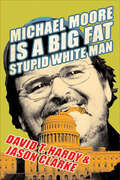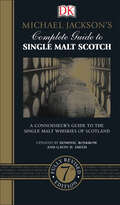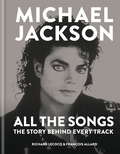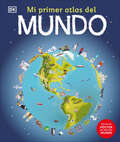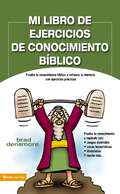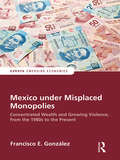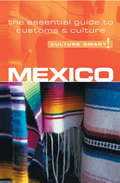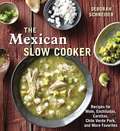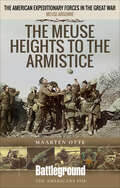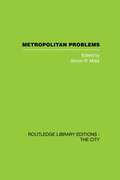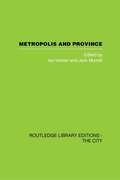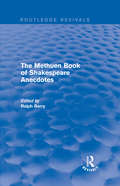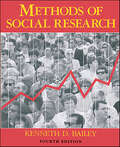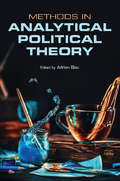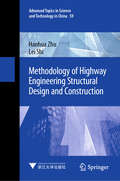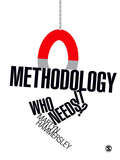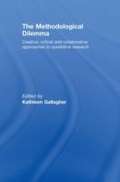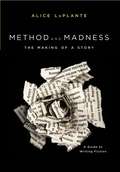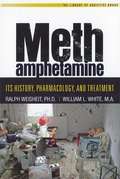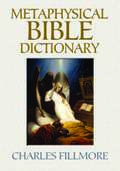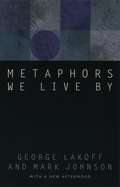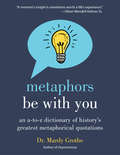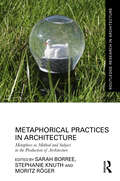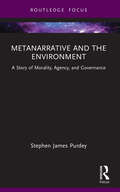- Table View
- List View
Michael Moore Is a Big Fat Stupid White Man
by David T. Hardy Jason ClarkeWatching Michael Moore in action—passing off manipulating facts in Bowling for Columbine, spinning statistics in Stupid White Men and Dude, Where's My Country?, shamelessly grandstanding at the Academy Awards, and epitomizing the hypocrisy he's made a king's fortune railing against—has spurred authors David T. Hardy and Jason Clarke to take action into their own hands. In Michael Moore Is a Big Fat Stupid White Man, Hardy and Clarke dish it back hard to the fervent prophet of the far left, turning a careful eye on Moore's use of camera tricks and publicity ploys to present his own version of the truth.Postwar documentarians gave us the documentary, Rob Reiner gave us the mockumentary, and Moore initiated a third genre, the crockumentary.How, they ask, does Moore pull off a proletarian, "man-of-the-people" image so at odds with his lifestyle as a fabulously wealthy Manhattanite? And how large of an impact do his incendiary, ill-founded polemics have on the growing community that follows him with near-religious devotion? Loaded with well-researched, solidly reasoned arguments, and laced with irreverent wit, Michael Moore Is a Big Fat Stupid White Man fires back at one of the left's biggest targets—politically and literally.
Michael Jackson's Complete Guide to Single Malt Scotch: A Connoisseur’s Guide to the Single Malt Whiskies of Scotland
by Dominic Roskrow Gavin D. SmithThe world's best-selling book on malt whisky, now updated to include all the latest significant bottlings.This seventh edition of Michael Jackson's Complete Guide to Single Malt Scotch continues to provide whisky enthusiasts with all the information, advice, and guidance they need to improve their knowledge and appreciation of single malt whisky.Fully updated with all the latest significant bottlings, Michael Jackson's Complete Guide to Single Malt Scotch includes an unrivaled A– Z of single malts with background information on the distilleries and tasting notes for more than 1,000 bottlings. It even provides each whisky with an overall score. Michael Jackson, regarded as the world's foremost authority on whisky until his death in 2007, originally authored this title. His legacy lives on in the 2015 edition edited by world-leading whisky consultants Dominic Roskrow and Gavin D. Smith.By giving practical advice on buying and collecting malts and interpreting whisky labels, and providing hundreds of color images, Michael Jackson's Complete Guide to Single Malt Scotch can turn any whisky novice into an informed veteran.
Michael Jackson: The Story Behind Every Track
by François Allard Richard LecocqPlease note: this edition is text only and does not contain images.This is the full story of every single song that Michael Jackson recorded and released during his long and remarkable solo career.With fascinating stories and detailed information on every track - as well as key early songs with The Jackson Five and his legendary dance moves and videos - All the Songs is the complete history of one of the greatest musical legacies of all time.Arranged chronologically by album, expert authors Lecocq and Allard explore the details behind early hits such as ABC and I Want You Back, to solo masterpieces such as Don't Stop 'Til You Get Enough, Billie Jean, Beat It, Smooth Criminal, Black or White, This Is It and more - including outtakes, duets and rare tracks.Explore the magic behind the King of Pop's music with this in-depth, captivating book.
Michael Jackson: The Story Behind Every Track
by François Allard Richard LecocqPlease note: this edition is text only and does not contain images.This is the full story of every single song that Michael Jackson recorded and released during his long and remarkable solo career.With fascinating stories and detailed information on every track - as well as key early songs with The Jackson Five and his legendary dance moves and videos - All the Songs is the complete history of one of the greatest musical legacies of all time.Arranged chronologically by album, expert authors Lecocq and Allard explore the details behind early hits such as ABC and I Want You Back, to solo masterpieces such as Don't Stop 'Til You Get Enough, Billie Jean, Beat It, Smooth Criminal, Black or White, This Is It and more - including outtakes, duets and rare tracks.Explore the magic behind the King of Pop's music with this in-depth, captivating book.
Mi primer atlas del mundo (Children's Illustrated Atlas)
by DKMi primer atlas del mundo' da vida al planeta con coloridos mapas y datos fascinantes sobre los países del mundo.Cada mapa está rebosante de información, combinando ilustraciones con fotografías que representan puntos clave sobre cada país. El atlas incluye un mapa mundial, con un mapa político para cada continente. Los niños aprenderán a leer mapas con leyenda, brújula y escala. Este libro encantador e informativo será una adición imprescindible para la biblioteca de cualquier niño.DK&’s 'Mi primer atlas del mundo' brings the world to life with colorful maps and fascinating facts about the countries of the world.Each map is bursting with information, combining colorful icons with photographs representing key points about each country. The atlas includes a world map, with a political map for each continent. Children are shown how to read a map and use a key, compass, and scale. This charming and informative book is a key addition to every child&’s library.
Mi libro de ejercicios de conocimiento bíblico
by Brad DensmoreDesarrolle masa cerebral al tonificar sus músculos de Matusalén. ¿Piensa que la Biblia es aburrida? ¡Piénselo de nuevo! Gran trivial bíblica le deleitará y asombrará con una colección divertida de trivialidades que cubren la Biblia entera. Desarrolle su conocimiento acerca de personas, lugares y cosas del Antiguo y Nuevo Testamentos, con pruebas de selección múltiple, listas de las diez mejores cosas, pruebas de verdadero o falso, e incluso algunas estrofas basadas en la Biblia que siguen las tonadas populares favoritas. Brad Densmore ofrece un verdadero reto de conocimiento bíblico con una dosis de humor en el camino, brindándole momentos sorprendentes tales como estos: • «¡Ay! Maneras dolorosas y desusadas de morir»: Sísara muerde el polvo después de su encuentro con el extremo puntiagudo de la estaca de una carpa. • «Lo que quiera que haga flotar su barco»: Noé tenía 600 años cuando sucedió el diluvio, ¿verdadero o falso? • «Las diez acciones de mayor valor del Antiguo Testamento»: Incluyendo Miqueasoft y Eclesiastés General. • ¿Qué tienen en común Tamar, Absalón y la sunamita? ¡Todos fueron notorios por su buena presencia! ¿Listo para hacer ejercicio? ¡Adelante! Usted no se ha divertido tanto desde que escondió un ratón en el escritorio de aquella estirada maestra de escuela dominical.
Mexico under Misplaced Monopolies: Concentrated Wealth and Growing Violence, from the 1980s to the Present (Europa Perspectives: Emerging Economies)
by Francisco E. GonzalezMexicans and those who follow Mexican affairs were optimistic in 2000 when the country experienced its first alternation in government (from the Partido Revolucionario Institucional –PRI--to the Partido Acción Nacional--PAN) in more than 70 years. Moreover, the Mexican economy had been restructured in a more open, market-led direction in the course of the 1980s and 1990s. The outcomes of these dual transitions were expected to create a new type of politics that were representative and accountable to citizens, and an economy that would grow rapidly, as it was forced to modernize by facing international competition. Some two decades later, views about Mexico are much less sanguine, and for many the country continues to follow a bipolar politico-economic trajectory characterized by periods of enthusiasm and mania which are followed by crisis and depression. This book presents a new analytical framework and reviews in detail Mexico’s political and economic history since the 1980s. The explanation offered is based on the idea of ‘misplaced monopolies’--i.e. an open political regime but a weak, fragmented state, and an internationally open economy, but highly concentrated economic sectors and activity in the domestic sphere. Accordingly, sown in the course of the crisis-ridden 1980s and 1990s, misplaced monopolies grew roots and became core features of Mexico’s political economy in the 2000s and 2010s. The end result has been great concentration of wealth in a small number of hands, and the dramatic growth in brutal violence in many parts of the country. From this perspective, unless ‘misplaced monopolies’ are reversed, conditions will remain prone to crisis, polarization, and conflict in Mexico. This volume concludes by extrapolating the framework and placing Mexico in comparative perspective, alongside internationally important countries such as Brazil, China, India, and Russia. This is a highly original investigation that will interest people who follow Mexican politics and its economy. The analytical framework will be of use to analysts, scholars, and students of comparative political economy, democratization studies, market reforms, and security and conflict studies.
Mexico - Culture Smart!
by Guy MavorCulture Smart! provides essential information on attitudes, beliefs and behavior in different countries, ensuring that you arrive at your destination aware of basic manners, common courtesies, and sensitive issues. These concise guides tell you what to expect, how to behave, and how to establish a rapport with your hosts. This inside knowledge will enable you to steer clear of embarrassing gaffes and mistakes, feel confident in unfamiliar situations, and develop trust, friendships, and successful business relationships.Culture Smart! offers illuminating insights into the culture and society of a particular country. It will help you to turn your visit-whether on business or for pleasure-into a memorable and enriching experience. Contents include* customs, values, and traditions* historical, religious, and political background* life at home* leisure, social, and cultural life* eating and drinking* do's, don'ts, and taboos* business practices* communication, spoken and unspoken"Culture Smart has come to the rescue of hapless travellers." Sunday Times Travel"... the perfect introduction to the weird, wonderful and downright odd quirks and customs of various countries." Global Travel"...full of fascinating-as well as common-sense-tips to help you avoid embarrassing faux pas." Observer"...as useful as they are entertaining." Easyjet Magazine"...offer glimpses into the psyche of a faraway world." New York Times
The Mexican Slow Cooker: Recipes for Mole, Enchiladas, Carnitas, Chile Verde Pork, and More Favorites
by Deborah SchneiderA collection of 55 fix it and forget it recipes for Mexican favorites from an award-winning Mexican cooking authority, in a stylish, engaging package. When acclaimed chef and cookbook author Deborah Schneider discovered that using her trusty slow cooker to make authentic Mexican recipes actually enhanced their flavor while dramatically reducing active cooking time, it was a revelation. Packed with Schneider's favorite south-of-the-border recipes such as Tortilla Soup, Zesty Shredded Beef (Barbacoa), famed Mole Negro, the best tamales she has ever made, and more,The Mexican Slow Cooker delivers sophisticated meals and complex flavors, all with the ease and convenience that have made slow cookers enormously popular.
The Meuse Heights to the Armistice: The American Expeditionary Forces in the Great War (Battleground The Americans 1918)
by Maarten OtteThe Americans had considerable initial success when they launched their huge offensive against the Germans in the Meuse-Argonne in the last days of September 1918. However, not everything went smoothly and the attack became bogged down, held up by the several lines of the Hindenburg System and logistical challenges. A major additional obstacle was the presence of batteries of German artillery on the high ground on the right bank of the Meuse, almost untroubled by any significant assaults by the allied forces. These guns created severe problems for the American commanders and their troops. Eventually sufficient resources were allocated for an American-French attack on the right bank, with the aim of removing the German artillery and pushing the Germans off the Meuse Heights, part of the renewed offensive on the Left Bank and the Argonne Forest. The action often took place over ground that had already seen ferocious fighting during the Battle of Verdun in 1916 and the French offensive of late summer 1917. It also involved the very difficult achievement of getting large bodies of troops over the River Meuse and its associated canal. The terrain is rugged and, even then, quite heavily wooded. The American and French troops often had to fight uphill and in the face of German defences that had been developed over the previous twelve months. On the other hand, the quality of the defending troops was not high, as Germany faced so much pressure in other sectors, and included a significant number of Austro-Hungarian troops. Popular opinion tends to be dismissive of the fighting quality of these Austrian troops who, in fact, performed well. The tours take the visitor over some beautiful countryside, with stunning views over the Meuse and the Woevre Plain. There are significant vestiges of the war still to be seen, including numerous observation bunkers and shelters as well as trenches. An unusual feature of the area are the traces of part of the Maginot Line, notably bunkers (some of which are very large) and the rail infrastructure to support it, sometimes making use of lines that the Germans built during the First World War. One of these tours follows the fate of Henry Gunther, officially the last American soldier to be killed in action in the Great War. There is substantial myth about Gunther; the facts surrounding his death are examined, as well as placing his last action on the ground. There is a tour dedicated just to him.
Metropolitan Problems
by S. MilesMetropolitan Problems is the end-product of one of the most dynamic research programmes of its kind ever conceived and executed. The book, which took three years to complete, represents the culmination of a two year study that was highlighted by a conference held in toronto in 1967. In the early 1960s, the bureau of Municipal Research (in metropolitan Toronto) decided that a significant way for it to celebrate Canada's centennial would be to initiate a systematic international study of the world's metropolitan areas. The study, with the official cooperation of the United Nations, was designed to produce positive insights into the methods of coping with the interlocking sets of problems associated with the expansion of the modern metropolis. Twelve papers on various aspects of metropolitan problems were commissioned from an international body of experts. Working with these experts were study groups drawn from forty major metropolitan centres throughout the world. After making exhaustive studies of their respective urban centres, the groups reported their findings and submitted detailed briefs through their representatives at the conference. Throughout the symposium, a conscious effort was made to examine single aspects of social, economic and physical change within the overall perspective of the metropolis. The book reflects this approach. Each chapter directs attention to specific problems of the metropolis, problems resulting from the contradiction between accelerating technology and our ability to cope with the incredible pace and rate of change. Together they prove that, despite differences in technology, culture, and political and social matters, the major urban areas of the world do have much in common. Emerging tendencies can be analysed and corrective and preventative measures be made through comparative analysis. This book was first published in 1970.
Metropolis and Province: Science in British Culture, 1780 - 1850
by Ian Inkster Jack MorrellThis collection of case studies, focusing on British scientific culture during the first industrial revolution, explores the social basis of science in the period and asks why such an extraordinarily rich variety of cultural-scientific experience should have flourished at the time. The book analyses science and scientific culture in their local contexts, both metropolitan and provincial, examining where possibel the relations between the two, and emphasizing the range of scientific associations in London, to individual savants in the provinces. This book was first published in 1983.
The Methuen Book of Shakespeare Anecdotes
by Ralph BerryFew playwrights have been more slandered, abused or honoured in performance than William Shakespeare. First published in 1992, this collection of 300 stories focuses on Shakespeare’s plays on stage. Organised chronologically, it offers the reader the opportunity to witness the changes in theatrical approaches to Shakespeare from their own time to the present day. This book will be of interest to those studying theatre, but also to those fascinated by the Shakespeare tradition.
Methods of Social Research
by Kenneth D. BaileyAn introduction for undergraduates to every stage of sociological research, showing how to deal effectively with typical problems they might encounter. The book is fully updated to include examples from the LA riots and the 1992 presidential elections.
Methods in Analytical Political Theory
by Adrian BlauThis is the first book to explain how to use key methods in analytical political theory. The methods discussed include contractualism, reflective equilibrium, positive political theory, thought experiments and ideological analysis. Many discussions of political theory methods describe and justify these methods with little or no discussion of their application, emphasizing 'what is' and 'why do' over 'how to'. This book covers all three. Each chapter explains what kinds of problems in political theory might require researchers to use a particular method, the basic principles behind the method being proposed, and an analysis of how to apply it, including concrete principles of good practice. The book thus summarizes methodological ideas, grouped in one place and made accessible to students, and it makes innovative contributions to research methods in analytical political theory.
Methodology of Highway Engineering Structural Design and Construction (Advanced Topics in Science and Technology in China #59)
by Hanhua Zhu Lei ShiThis book mainly studies the methodologies of structural design and construction for highway engineering, which are applicable to the overall control and the precise operation of engineering structures. It explores the method of comprehensive analysis, the simplification of complex problems, and the application of typical engineering tools. In turn, the book presents a number of innovative approaches, e.g. the coordinated control of structural deformation method, the theory of underground engineering balance and stability, and the soft soil foundation treatment of “bumping at the bridgehead.” These methodologies are then illustrated in typical cases and representative problems, explained from a practical standpoint. Examples in special settings are also discussed, e.g. highway construction in Tibet, and rebuilding after the Wenchuan earthquake. The book offers a valuable reference guide for all those whose work involves highway engineering design, construction, management, and scientific research.
Methodology: Who Needs It?
by Martyn HammersleyThe literature on social science methods and the issues surrounding them has grown massively and continues to increase. Yet many social scientists are ambivalent about methodology. For some, it plays a central, perhaps even an all-encompassing, role; while, for others, it is desirable only in small amounts, or indeed is regarded as an irrelevance, as a distraction from actually doing research. In this book, Hammersley argues that, in large part, this reflects and is part of a wider problem: the gradual decline of a previously influential academic model of inquiry. This has occurred as a result of ideological challenges and the erosion of the institutional conditions that support academic work. He defends this model, spelling out the demands it places upon social scientists, and examining such issues as the proper role of methodology, the nature of objectivity, the false idea that social scientists should be intellectuals or social critics, the dialectic of academic discussion, the ethics of belief, and the limits of academic freedom. More broadly, he also questions the role of the social research within society and what it means to be a social scientist in the 21st century. Hammersley's book is engagingly written and controversial. It tackles the major issues of contemporary social research methodology head on and is an essential read for anyone with an interest in this field.
The Methodological Dilemma: Creative, Critical and Collaborative Approaches to Qualitative Research
by Kathleen GallagherBoth thought-provoking and challenging to the way research is planned and undertaken, this vital new book will equip researchers with a variety of critical, creative and post-positivist solutions to dilemmas that plague qualitative research.
Method and Madness: The Making of a Story: A Guide to Writing Fiction
by Alice LaplanteMethod and Madness takes its title from Hamlet: “Though this be madness, yet there is method in't.” Comprehensive and accessible, it provides guidelines to all aspects of fiction writing, from generating ideas to getting published. With a wealth of imaginative yet practical exercises and 39 stories—the most in any guide to fiction writing—Method and Madness offers friendly, down-to-earth instruction in the art and craft of fiction.
Methamphetamine: Its History, Pharmacology and Treatment
by Whilliam L. White Ralph WeisheitThe definitive book on the impact of methamphetamine on individuals, communities, and society by two of America's leading addiction and criminal justice experts.In recent years, the media have inundated us with coverage of the horrors that befall methamphetamine users, and the fires, explosions, and toxic waste created by meth labs that threaten the well-being of innocent people. In Methamphetamine: Its History, Pharmacology, and Treatment, the first book in Hazelden's Library of Addictive Drugs series, Ralph Weisheit and William L. White examine the nature and extent of meth use in the United States, from meth's early reputation as a "wonder drug" to the current perception that it is a "scourge" of society.In separating fact from fiction, Weisheit and White provide context for understanding the meth problem by tracing its history and the varying patterns of use over time, then offer an in-depth look at:the latest scientific findings on the drug's effects on individualsthe myths and realities of the drug's impact on the mindthe national and international implications of methamphetamine productionthe drug's impact on rural communities, including a case study of two counties in the Midwestissues in addiction and treatment of meth.Thoroughly researched and highly readable, Methamphetamine offers a comprehensive understanding of medical, social, and political issues concerning this highly impactful drug.Written for professionals and serious lay readers by nationally recognized experts, the books in the Library of Addictive Drugs series feature in-depth, comprehensive, and up-to-date information on the most commonly abused mood-altering substances.
Metaphysical Bible Dictionary (Dover Empower Your Life Ser.)
by Charles FillmoreA notable product of the 19th-century New Thought revolution, Charles Fillmore's Unity movement combined esoteric and metaphysical principles with traditional Christian elements. This key to Fillmore's original form of religious expression, a core text of the Unity movement, interprets the hidden meanings of the Bible's myriad names, places, and events.
Metaphors We Live By
by George Lakoff Mark JohnsonThe now-classic Metaphors We Live By changed our understanding of metaphor and its role in language and the mind. Metaphor, the authors explain, is a fundamental mechanism of mind, one that allows us to use what we know about our physical and social experience to provide understanding of countless other subjects. Because such metaphors structure our most basic understandings of our experience, they are "metaphors we live by"—metaphors that can shape our perceptions and actions without our ever noticing them. In this updated edition of Lakoff and Johnson's influential book, the authors supply an afterword surveying how their theory of metaphor has developed within the cognitive sciences to become central to the contemporary understanding of how we think and how we express our thoughts in language.
Metaphors Be With You: An A to Z Dictionary of History's Greatest Metaphorical Quotations
by Dr Mardy GrotheRespected quotation anthologist and author of Oxymoronica and Viva la Repartee Dr. Mardy Grothe is at his best in Metaphors Be with You, an A to Z dictionary of 2,750 of history's greatest metaphorical quotations, meticulously curated for writers, readers, and quotation lovers everywhere.In Metaphors Be with You, Dr. Mardy Grothe has created the definitive reference on English's finest metaphors, sourced from literature, politics, philosophy, Hollywood, religion, sports, comedy, history, religion, pop culture, and more. Arranged into two sections--"The Ten Best Things Ever Said" and "The Single Best Thing Ever Said"--Metaphors Be with You includes quotations on five hundred human interest topics and an introduction to the nature, importance, and sheer joy of metaphorical language.Essential for writers, readers, and language aficionados, this breathtaking, beautifully designed sourcebook also contains elegantly integrated digital access to Dr. Mardy's Dictionary of Metaphorical Quotations, the world's largest online database of quotations containing metaphors, similes, and analogies. This one-of-a-kind synergy between print and technology offers a comprehensive look at the diversity of words and phrases we use to relate to, understand, and describe our world by providing access to detailed source information, innumerable "Error Alerts," and fascinating quotation backstories that will engage readers as they delve into metaphorical language and discover their own favorites.Whether you're crafting a speech, writing a novel, or simply searching for new ways to express yourself, this remarkable compendium is sure to inspire you with the perfect metaphor every time.
Metaphorical Practices in Architecture: Metaphors as Method and Subject in the Production of Architecture (Routledge Research in Architecture)
by Sarah Borree Stephanie Knuth Moritz RögerMetaphors are diversly and intricately embedded in architectural practice and discourse. Precisely for this reason, this volume argues and sets out to explore, how they can be engaged to critically interrogate architecture’s social, cultural and political dimensions – past and present – and to productively challenge and intervene with established perspectives, debates and practices. Mapping out not just potentials but also addressing the challenges, limitations and dangers inherent in using metaphors in architectural research and practice, the volume prominently illustrates the ambiguity and contradictoriness inherent in both metaphors and the process of engaging and exploiting them. Covering a broad range of historical and geographical cases and concerns, the contributions illustrate effectively that metaphors can expand or narrow our engagement with architecture, and consolidate or legitimise but also destabilise and challenge established social, cultural, disciplinary and political structures, concepts and categories. With its aim to explore metaphors as both subject and method to critically challenge and expand established practices, perspectives and standards in architectural research and practice, the volume will be of interest for scholars working across the architectural humanities, including architectural history, theory, culture, design and urbanism, as well as for researchers concerned with architecture and the city from fields such as cultural, visual and area studies as well as art history.
Metanarrative and the Environment: A Story of Morality, Agency, and Governance (Routledge Research in Environmental Policy and Politics)
by Stephen James PurdeyTo meet the challenge of global environmental degradation activists have tackled clear and concrete problems such as carbon emissions and climate change, the ruination of ecosystems and habitat, the precipitous loss of biodiversity, and many other unhappy consequences of irresponsible human behaviour. However, all such efforts to manually correct the course of history have been dwarfed by the magnitude and heavy forward momentum of modern industrial society. In Metanarrative and the Environment, Stephen James Purdey argues that material approaches to the environmental crisis cannot succeed without the power of a legitimating discourse – a new metanarrative – which fundamentally changes the ideational landscape of human development. Dr. Purdey begins in Part I by establishing the pragmatics of our environmental predicament – its roots and responses to it. He focuses on the concept, definition, and key features of metanarrative, introducing the hegemonic story that now rules the contemporary global mindscape. Part II takes on the moral problematic more directly, encouraging the evolution of a new metanarrative by bringing our potential for agency in the face of danger into sharper relief. Metanarrative and the Environment is multidisciplinary, with a particular emphasis on the creative humanities. It will be of interest to undergraduate and graduate students alike, as well as environmental activists and academics looking for a new way forward.
